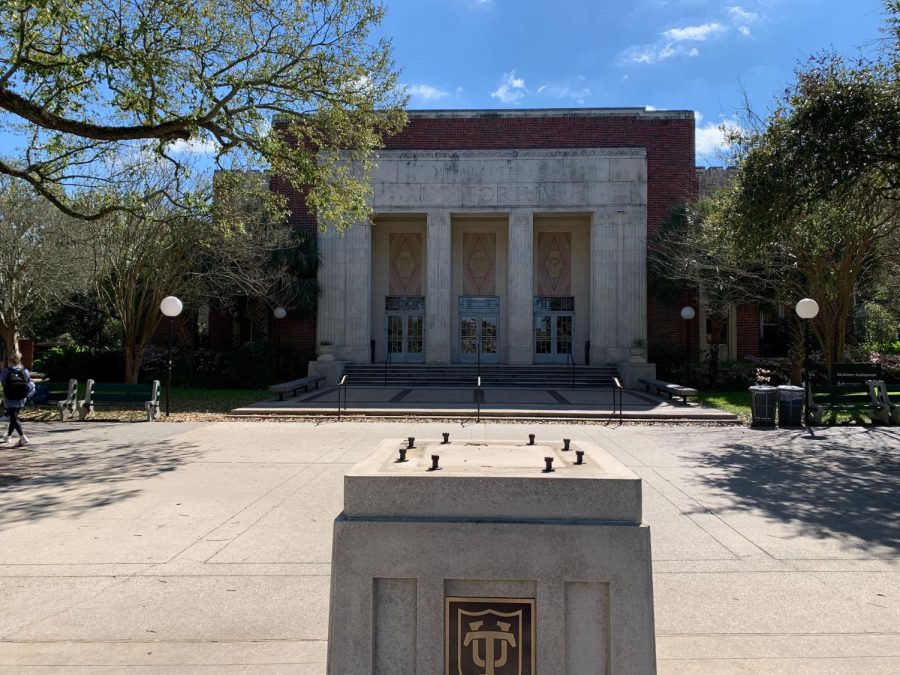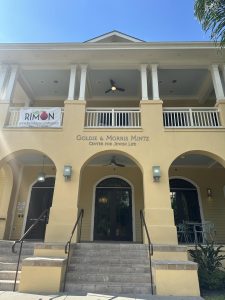Tulane removes ‘Victory Bell’ from McAlister, cites symbol’s connection to slavery
Shahamat Uddin | Senior Staff Photographer
The view from McAlister Drive where Tulane’s ‘Victory Bell’ once stood.
February 27, 2020
As students made their morning commutes to class on Thursday, something distinct was missing from the familiar route: the McAlister Victory Bell. The bell was removed today after a discovery from a Tulane staff member was shared with President Fitts that the iconic campus symbol was originally a plantation bell.
According to the email, historical archives confirmed that the bell was made in 1825. For enslaved Africans who were not given their own pocket watches or clocks to check the time, the bell was used to communicate daily schedules. It was then brought to Tulane in 1960-61.
President Mike Fitts and Board of Tulane Chair Doug Hertz formally announced the news in an email this morning.
“As an academic institution, we believe it is important to find a way to use this bell to further our knowledge and understanding of slavery and pursue a more just society,” Fitts and Hertz said in the email.
The decision to remove the bell was determined by Fitts and the bell has been moved to storage as the presidential commission continues to investigate its exact history.
The bell was a prominent symbol of Tulane used to celebrate basketball games and class commencements. The symbol was also featured on photographs across campus, including a large image on a stairwell of the Lavin-Bernick Center for University Life. That image has already been replaced with an image of Crawfest, another Tulane tradition.
A special committee including students, faculty, alumni and staff will decide what will replace the bell’s spot in front of McAlister Auditorium.
“In doing so, we hope to establish a new tradition that truly represents a victory for all,” the email read.
In May of 2019, a college at the University of Cambridge similarly removed a bell they suspected to be linked to slavery. In light of their discovery, The University of Cambridge began a two-year study on how their institution benefited from the slave trade.
Correction: A previous version of this article stated the decision to remove the bell came out of the Presidential Commission on Race and Tulane Values. The decision was made by President Fitts after the discovery was shared with him.









William Klein • Mar 5, 2020 at 7:46 pm
I was hoping my alma mater wouldn’t succumb to PC BS. To much to expect I suppose.
JOHN FIELD • Mar 5, 2020 at 4:20 pm
The most interesting thing about this tempest in a teapot, er, victory bell is the ensuing hullabaloo streaming here. A nice microcosm of America 2020 at rhetorical war with itself.
Jill Peters • Mar 5, 2020 at 11:53 am
One can also look as the bell as HISTORY. That is what it is… a piece of history. One can also look at the bell and see how far we have come. It is perspective. It is a positive symbol.
Victor Avalos • Mar 5, 2020 at 9:53 am
If the bell is still around, it should be put back along with a plaque that explains its origin and how now it is a symbol of freedom and a tribute to all who endured those troubled times. A bell is such a perfect symbol.
Eugenie Ricau Rocherolle N '58 • Mar 3, 2020 at 7:04 pm
Twelve American presidents owned slaves and eight were slave owners while in office. Does that mean we have to remove all monuments throughout the U.S., change the names of schools and universities and demolish Mt. Rushmore? Enough, already!
Ryan • Mar 2, 2020 at 7:58 am
Need to change the name of the ” University ” now; how about Oceania University?
Robert E. Lee • Mar 1, 2020 at 2:39 pm
I hope the whole city sinks into the ocean…
Vera • Mar 1, 2020 at 9:58 am
Try someone kneeling for prayer as a symbol.
Irvin West • Feb 29, 2020 at 10:29 pm
The university is named after Paul Tulane, a French immigrant to New Jersey, who was a major New Orleans contributor to the Confederacy, helped fund Confederate monuments in Greenwood Cemetery in New Orleans, etc Dam ‘selective political correctness’, you just can not make this stuff up.
Jacques Walker • Feb 28, 2020 at 8:02 pm
Besides it’s location on top of a former plantation, it’s benefactor, Paul Tulane, was the largest financial donor to the Confederacy from New Orleans. After the war, Tulane donated large sums of money to erect Confederate Monuments throughout New Orleans.
Based on the logic for removing that bell, perhaps a name change is due!!!
Jacques Walker • Feb 28, 2020 at 5:41 pm
If you are going to remove the bell because of its connection to slavery, then Tulane had better prepare to relocate the campus. It currently sits right on top of the old Etienne de Bore’ sugar plantation. It had lots of sugar and, unfortunately, lots of slaves.
Matthew Dillon • Feb 28, 2020 at 1:15 pm
The University of Cambridge did a two year study on the Plantation Bell that had links to the Slave Trade and it was recently removed at the Tulane Campus. The Tulane Campus was built on a Sugar Plantation, The University of Cambridge was not. Why is it relevant that we remove history that is associated with our origins? The Entire French Quarter buildings were also built with “Slave Labor” . Should we take that down as Well?
David • Feb 28, 2020 at 11:23 am
More erasing of history. People say they don’t want to erase history but that is exactly what they are doing is trying to erase history. Apparently we shouldn’t have anything that deals with the past like slavery.
Sean • Feb 28, 2020 at 11:19 am
So, there’s no evidence THIS PARTICULAR BELL had anything to do with slavery??? Just “bells at that time were used to communicate on farms that could have had slaves”? Were bells used on farms without slaves? Were bells used anywhere else for any purpose? I understand rakes and shovels were used on farms by slaves. So the university should ban rakes and shovels from campus. We should also note some slaves were known to wear pants and eat carrots. They need to be banned. Since Tulane University used to not admit slaves, it’s obvious the university needs to shut down, bulldoze all buildings and ban itself from existence in order to be fully inclusive.
John • Feb 28, 2020 at 11:03 am
Paul Tulane donated more money to the Confederate cause than anyone in N.O.. Why don’t you rename the university or demolish it?
You people have lost all common sense. And you claim to be educators?
Larry Masters • Feb 28, 2020 at 10:46 am
I didn’t know that inanimate objects could be imbued with evil. Who is the administration trying to appease? A bell is just forged or cast metal that makes nice ring. There is nothing good or bad about it. The green thing to do is to recycle and reuse. Put the bell back and get over trying to justify the existence of a silly truth commission.
Just when I thought we hit the peak of idiocracy, I learn something new.
Dr. Daniel Nation, Major USAF (Ret.) • Feb 28, 2020 at 10:05 am
Don’t tell anyone. The university is named after Paul Tulane, a French immigrant to New Jersey, who was a major New Orleans contributor to the Confederacy, helped fund Confederate monuments in Greenwood Cemetery in New Orleans, and was one of the most generous contributors to the Ladies’ Benevolent Association of Louisiana; an institution dedicated to producing Confederate monuments. The university was renamed after a very large contribution in 1884 from Tulane. Maybe the university should return Tulane’s donation and change their name back to the University of Louisiana? Just saying.
Bullwinkle • Feb 28, 2020 at 9:34 am
When an idea to create a tradition goes bad! A bell with unknown meaning? This isn’t Philadelphia.
I am a two-time graduate and my son also graduated from Tulane, recently. We never had this sort of tradition when I attended and I found it odd when I saw the bell when my son attended.
How about just letting the unique NOLA experiences speak for themselves? And let’s look forward, not backward. Maybe put a tree in its place…
Steve Hale • Feb 28, 2020 at 8:08 am
More silly Fascist PC BS run amok.
Nothing More.
History is History – it has no Agenda.
Unlike these Self-Righteous Ingrates.
It’s time for all People of Good Will to stand together and say “No More!” to the Cultural and Historical Genocide of the South.
DEO VINDICE!
Lehrue stevens • Feb 28, 2020 at 8:08 am
Eradicate don’t educate- must have had a hissy fitt
curtiss L. Poteat • Feb 28, 2020 at 7:34 am
What a bunch of pussy’s, it’s a bell, it had no say so in it’s use then or now. I don’t know a lot about Tulane and could really care less, but will you drain the school’s pool if someone were to drown in it.
Jeff • Feb 28, 2020 at 6:52 am
I wish you could just step back and see just how stupid you look. Weak minded pussies. A bell. A fucking bell.
Connie Chastain • Feb 28, 2020 at 1:19 am
If it weren’t for plantations, there wouldn’t be any black people in the USA.
john • Feb 28, 2020 at 1:02 am
Hey, I know what to do. Paul Tulane donated the largest funds of anyone in N.O. to the Confederate cause. Let’s tear down Tulane University.
John • Feb 28, 2020 at 12:57 am
This is ridiculous. You are looking for anything made before 1865 to trash, just because it was around in the slavery period. Why don’t we start tearing down all the building that slaves were forced to construct? So much for a college education. All it does is sap you of common sense.
Scott Darnall • Feb 27, 2020 at 10:59 pm
Pure madness. I was looking forward to attending some Tulane Baseball games. Not happening now. How dumb is this crap going to get. You lost this long time Tulane Fan with this garbage.
Karl Burkhalter • Feb 27, 2020 at 8:56 pm
This Iconoclastic Mania is Orwelian cultural cleansing and shows the dirth of Tulane’s a academic integrity. 19th Century saw genocide against Native Americans and Blacks at Bosque Redondo and Devil’s Punchbowl Natchez, along with children working 12-14 hours a day in Northern Mines and Factories. Be honest a cut the PC Virtue Signaling!
Jo Mama • Feb 27, 2020 at 7:02 pm
It is absolutely amazing what a bunch of whining crying snowflake pussies Tulane, her administration, her faculty and her student body has become. I am ASHAMED to be an alumnus of what was once one of the finest universities in the country.
Gersrd • Feb 27, 2020 at 6:12 pm
What a waste of time and energy. Focus on educating everyone on the history. It may be painful but it is about education.
Michael Chutz • Feb 27, 2020 at 5:17 pm
Melt the Bell add metal from Chains with Slavery history then recast a Victory Inclusive Bell
Edward • Feb 27, 2020 at 4:56 pm
So, rather than keep the bell and use it to educate people about what a horrific thing slavery was, the school decided to remove it and hope that it could hide an ugly part of our history. Well, we might was well ban rock and roll. After all, its roots originate in the call and response music used by slaves in the fields, as well as the blues played by poor, oppressed blacks in America’s south.
Instead of removing the bell, a better idea would have been to put a commemorative plaque on the support that explained its history and reminded students and guests of the university to never forget the inhumane suffering that once happened here.
There is a reason that Jews (like me) want to keep concentration camps in tact (as museums). They serve as powerful reminders to never let atrocities like the Holocaust ever happen again. If these camps were simply bulldozed out of existence at the end of World War II, it would be even easier for the Holocaust deniers to spread their lies (I had many relatives perish at the hands of the Nazis in Europe).
Hiding things from our past can’t change the past. Keeping things from our past can educate future generations not to make the same mistakes.
Michael Owens • Feb 27, 2020 at 4:48 pm
Wow! What a giant blow against injustice! Please.
Finding this out… just makes me want to bulldoze the entire campus.
I think they should just shut down the entire university.
This article has to be a joke..
Chip Duncan • Feb 27, 2020 at 3:12 pm
Need to consider this:
THE BOBBY BOUDREAU SPIRIT AWARD
Bobby Boudreau (B ’51, L ’53) was a most beloved cheerleader of all things Tulane. When he received the Volunteer Alumnus award in 2009, he chose for his acceptance speech to lead the room in the Hullabaloo cheer.
Watch the video >>
He wore green and bled green. Even when he was wheelchair-bound, he continued to travel from Lake Charles to New Orleans and elsewhere to attend football and baseball games. When he left us on Super Bowl Sunday on February 7, 2010, a Tulane light certainly dimmed.
To honor his memory, the university has established the Bobby Boudreau Spirit Award which is given annually at Homecoming. In addition, the victory bell has been dedicated as the Bobby Boudreau Spirit Bell.
https://alumni.tulane.edu/s/1586/Alumni/16/interior.aspx?sid=1586&gid=3&pgid=2171
Booby Boudreau was a wonderful man.